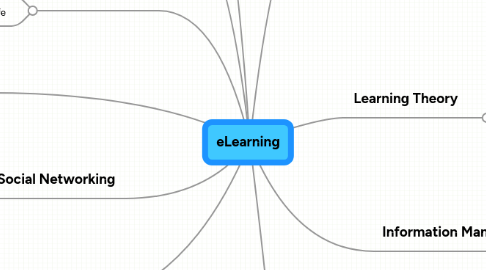eLearning
von Andrew Hill


1. Trends *1
1.1. Managing Relationships
1.1.1. Distributing Co-creation
1.1.2. Using consumers as innovators
1.1.3. Tapping into a world of talent
1.1.4. Extracting more value from interactions
1.2. Managing capital and assets
1.2.1. Expanding automation
1.2.2. Unbundle production from delivery
1.3. Leveraging information in new ways
1.3.1. Putting science into management
1.3.2. Making businesses from information
2. User-created content
2.1. Blogs
2.2. Wiki's
2.3. Discussion Boards
2.4. YouTube
2.5. PhotoBucket
2.6. Mind-maps
3. Social Networking
3.1. FaceBook
3.2. MySpace
3.3. Xing
3.4. LearningTown
3.5. http://en.wikipedia.org/wiki/List_of_social_networking_websites
4. Mobile Telephony
4.1. Wireless v 3G
4.2. Ajax and Rich Application Interfaces
4.3. Smart phones
5. Virtual Worlds
5.1. Gaming
5.1.1. Simulations
5.2. Second Life
6. Platforms
6.1. Learning Management Systems
6.2. Content Management System
6.3. SmartBoards
6.4. Video-conferencing
7. Technology
7.1. Email
7.2. RSS
8. Information Management
8.1. Library
8.1.1. Catalogue
8.1.2. Journals
8.2. Taxonomy
8.3. Enterprise Content Management
9. Knowledge Management
9.1. Strategy
9.1.1. Social Network Analysis
9.1.2. Knowledge Audit
9.2. Management
9.2.1. Blame Vs Gain
9.2.2. Force Field Analysis
9.2.3. SECI
9.3. Collaboration
9.3.1. Six Hats
9.3.2. Communities of Practice
9.3.3. Action Learning
9.4. Knowledge Sharing
9.4.1. After Action Reviews
9.4.2. Stories
9.5. Capture
9.5.1. Taxonomies
9.5.2. Exit Interviews
9.5.3. Blogs & Wikis
10. Learning Theory
10.1. MBTI
10.2. OADI - Kolb
10.2.1. Think
10.2.1.1. Observe
10.2.1.2. Reflect/Assess
10.2.2. Act
10.2.2.1. Design
10.2.2.2. Implement
